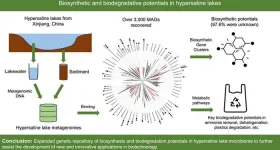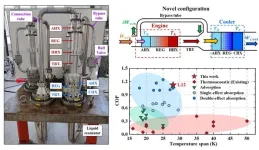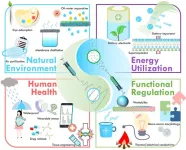(Press-News.org) During the COVID-19 pandemic, lower occupancy in buildings led to reduced water use, raising concerns about water quality due to stagnation. Government warnings highlighted increased risks of chemical and microbiological contamination in water systems. Studies showed that reduced usage and stagnation could elevate heavy metal levels and decrease disinfectant effectiveness, affecting microbial growth. To address this, regular fixture flushing was recommended, which temporarily improved water quality but also revealed the complexities of managing building water systems effectively.
In a recent study (https://doi.org/10.1016/j.ese.2023.100314) published in Volume 18 of the journal Environmental Science and Ecotechnology, reveals crucial insights into the impact of reduced building occupancy on water quality.
Conducted at Purdue University, this research explored the impact of reduced building occupancy during the COVID-19 pandemic on water quality. The study focused on four buildings with varied characteristics and assessed water quality changes during low-use periods. Monitoring key parameters such as heavy metal concentrations and chlorine levels, it evaluated the effects of water stagnation.
The findings showed that prolonged stagnation led to significant variations in water quality, including changes in heavy metal and chlorine levels. These variations were influenced by factors like the building's age, size, and water system design. The study also assessed the effectiveness of flushing practices, a method to refresh stagnant water in plumbing systems.
The results revealed that while flushing could alleviate some of the negative effects of stagnation, its effectiveness varied across different building types, highlighting the complexity of managing water quality in buildings with changing occupancy levels. This research underscores the importance of developing customized water management strategies, particularly during unexpected events like pandemics, which can significantly alter building usage patterns.
Highlights
No standard plumbing flushing guidance was available.
Four low occupancy institutional buildings (with the same source) were sampled.
Chlorine residual was often not detected across all buildings.
No chlorine was detected at the entry of 1 building after flushing for 7 h.
No widespread Cu, Mn, Pb, and Zn contamination was found.
Lead researcher Kyungyeon Ra, along with a team from Purdue University, underscores the significance of this research in understanding the changes in water quality due to altered building occupancy patterns during the pandemic.
This study highlights the need for effective water management strategies in buildings with low occupancy. The findings have implications for public health, particularly in understanding and mitigating risks associated with water stagnation and devising appropriate flushing protocols.
###
References
DOI
10.1016/j.ese.2023.100314
Original Source URL
https://doi.org/10.1016/j.ese.2023.100314
Funding information
The U.S. National Science Foundation (NSF) RAPID (2027049); The US NSF Graduate Research Fellowship (NSF GRFP) Grant under (DGE-1333468). U.S; Environmental Protection Agency (EPA) funding (R836890). The Purdue University Doctoral Fellowship and the Purdue University Lillian Gilbreth Postdoctoral Fellowship.
About Environmental Science and Ecotechnology
Environmental Science and Ecotechnology (ISSN 2666-4984) is an international, peer-reviewed, and open-access journal published by Elsevier. The journal publishes significant views and research across the full spectrum of ecology and environmental sciences, such as climate change, sustainability, biodiversity conservation, environment & health, green catalysis/processing for pollution control, and AI-driven environmental engineering. The latest impact factor of ESE is 12.6, according to the Journal Citation ReportTM 2022.
END
Pandemic lockdowns and water quality: a revealing study on building usage
2024-02-01
ELSE PRESS RELEASES FROM THIS DATE:
Exploring the unseen: microbial wonders in earth's saltiest waters
2024-02-01
The study delves into hypersaline lakes in Xinjiang, China, exploring the genetic and metabolic diversity of microbial communities termed "microbial dark matters". Hypersaline lake ecosystems, characterized by extreme salinity, harbor unique microorganisms with largely unexplored biosynthesis and biodegradation capabilities. The research seeks to uncover novel biological compounds and pathways, potentially revolutionizing biotechnology, medicine, and environmental remediation by tapping into the untapped potential of these extremophiles.
A recent study (https://doi.org/10.1016/j.ese.2023.100359) published ...
As cancer therapies improve, more patients with rectal cancer forego surgery
2024-02-01
While surgery to remove rectal cancer can be necessary and lifesaving, it can sometimes come with significant drawbacks, like loss of bowel control. According to a study led by Wilmot Cancer Institute researchers, patients with rectal cancer who respond well to radiation and chemotherapy are increasingly foregoing surgery and opting for a watch-and-wait approach.
The study, published in JAMA Oncology, shows that the number of patients opting out of surgery rose nearly 10 percent between 2006 and 2020. These data reflect a shift toward what ...
Stanford Medicine-led study shows why women are at greater risk of autoimmune disease
2024-02-01
Somewhere between 24 and 50 million Americans have an autoimmune disease, a condition in which the immune system attacks our own tissues. As many as 4 out of 5 of those people are women.
Rheumatoid arthritis, multiple sclerosis and scleroderma are examples of autoimmune disorders marked by lopsided female-to-male ratios. The ratio for lupus is 9 to 1; for Sjogren’s syndrome, it’s 19 to 1.
Stanford Medicine scientists and their colleagues have traced this disparity to the most fundamental feature differentiating ...
Researchers develop highly efficient heat-driven thermoacoustic refrigerator
2024-02-01
Researchers led by Prof. LUO Ercang from the Technical Institute of Physics and Chemistry (TIPC) of the Chinese Academy of Sciences and their collaborators have developed an innovative heat-driven thermoacoustic refrigerator (HDTR) with a novel bypass configuration that significantly improves the efficiency of this technology.
The study was published in Cell Reports Physical Science on Feb. 1.
HDTR is recognized as a new, promising cooling technology with many advantages. For example, it has no moving parts, uses eco-friendly substances (e.g., helium and nitrogen), and is highly reliable. However, its relatively low efficiency ...
Animals: Small, long-nosed dogs live the longest
2024-02-01
Small long-nosed (or dolichocephalic) dog breeds such as Whippets have the highest life expectancies in the UK, whilst male dogs from medium-sized flat-faced (or brachycephalic) breeds such as English Bulldogs have the lowest. The results, published in Scientific Reports, have been calculated from data on over 580,000 individual dogs from over 150 different breeds, and could help to identify those dogs most at risk of an early death.
Kirsten McMillan and colleagues assembled a database of 584,734 individual dogs using data from 18 different UK sources, including breed registries, vets, pet insurance companies, animal welfare ...
Physical activity and cognitive decline among older adults
2024-02-01
About The Study: Physical activity was associated with better late-life cognition, but the association was weak in this systematic review and meta-analysis including 104 studies with 341,000 participants. However, even a weak association is important from a population health perspective.
Authors: Paula Iso-Markku, M.D., Ph.D., of the University of Helsinki, Finland is the corresponding author.
To access the embargoed study: Visit our For The Media website at this link https://media.jamanetwork.com/
(doi:10.1001/jamanetworkopen.2023.54285)
Editor’s Note: Please see the article for additional information, including other authors, author contributions ...
Cerebral cortical surface structure and neural activation pattern among adolescent football players
2024-02-01
About The Study: In this study of 205 adolescent football players and 70 noncontact control athletes, there was evidence of discernible structural and physiological differences in the brains of adolescent football players compared with their noncontact controls. Many of the affected brain regions were associated with mental health well-being.
Authors: Keisuke Kawata, Ph.D., of Indiana University in Bloomington, is the corresponding author.
To access the embargoed study: Visit our For The Media website at this link https://media.jamanetwork.com/
(doi:10.1001/jamanetworkopen.2023.54235)
Editor’s ...
BU professor to serve on the National Academies’ New Voices in Sciences, Engineering, and Medicine Program
2024-02-01
(Boston)—Sabrina A. Assoumou, MD, MPH, the inaugural Louis W. Sullivan, MD, Professor of Medicine, and an associate professor of medicine at Boston University Chobanian and Avedisian School of Medicine, has been selected to serve in the 2024-2026 cohort of New Voices in Sciences, Engineering, and Medicine at the National Academies. Participants are selected in recognition of outstanding achievements and the program provides an opportunity to identify and address pressing concerns for the nation.
New Voices ...
The ShAPE of buildings to come: Scrap aluminum transforms recycling life cycle
2024-02-01
RICHLAND, Wash.—The circular economy just closed the loop on scrap aluminum, thanks to a new patent-pending technology developed at the Department of Energy’s Pacific Northwest National Laboratory. That twisted aluminum mesh, those banged up bicycle frames, and the used car parts now languishing in junk yards could gain new life as building structures such as door and window frames, facades, lighting, decorative features and a myriad of other uses—all while conserving nearly all the energy required to manufacture new aluminum products.
It’s no secret that strong, yet light-weight aluminum parts are being ...
A positive spin—electrospinning and electrospraying synergism for the nanomaterials industry
2024-02-01
Combining these two twins-tech, electrospinning and electrospraying, to fabricate novel nanomaterials is an urgent area of research for materials scientists and biomedical engineers, according to a new paper by Professor Hu Jinlian of City University of Hong Kong (CityUHK) published in Matter, a highly respected monthly journal encompassing materials science, from nano to macro, and from fundamentals to application.
The electrospinning and electrospraying synergism (ESS) can positively impact diverse sectors, from bioengineering and ...




